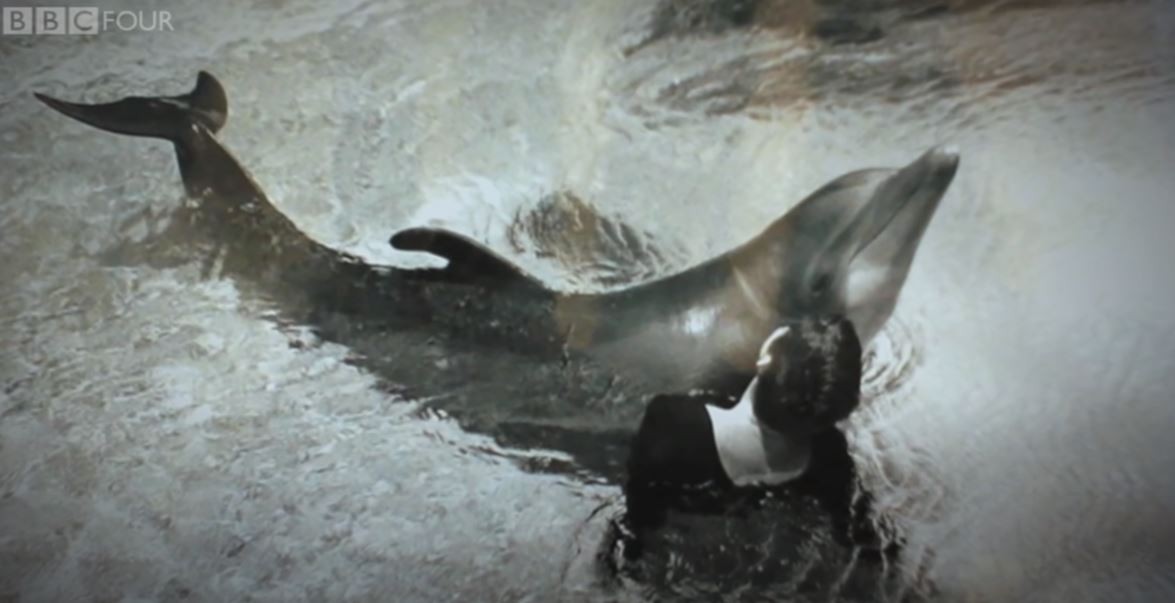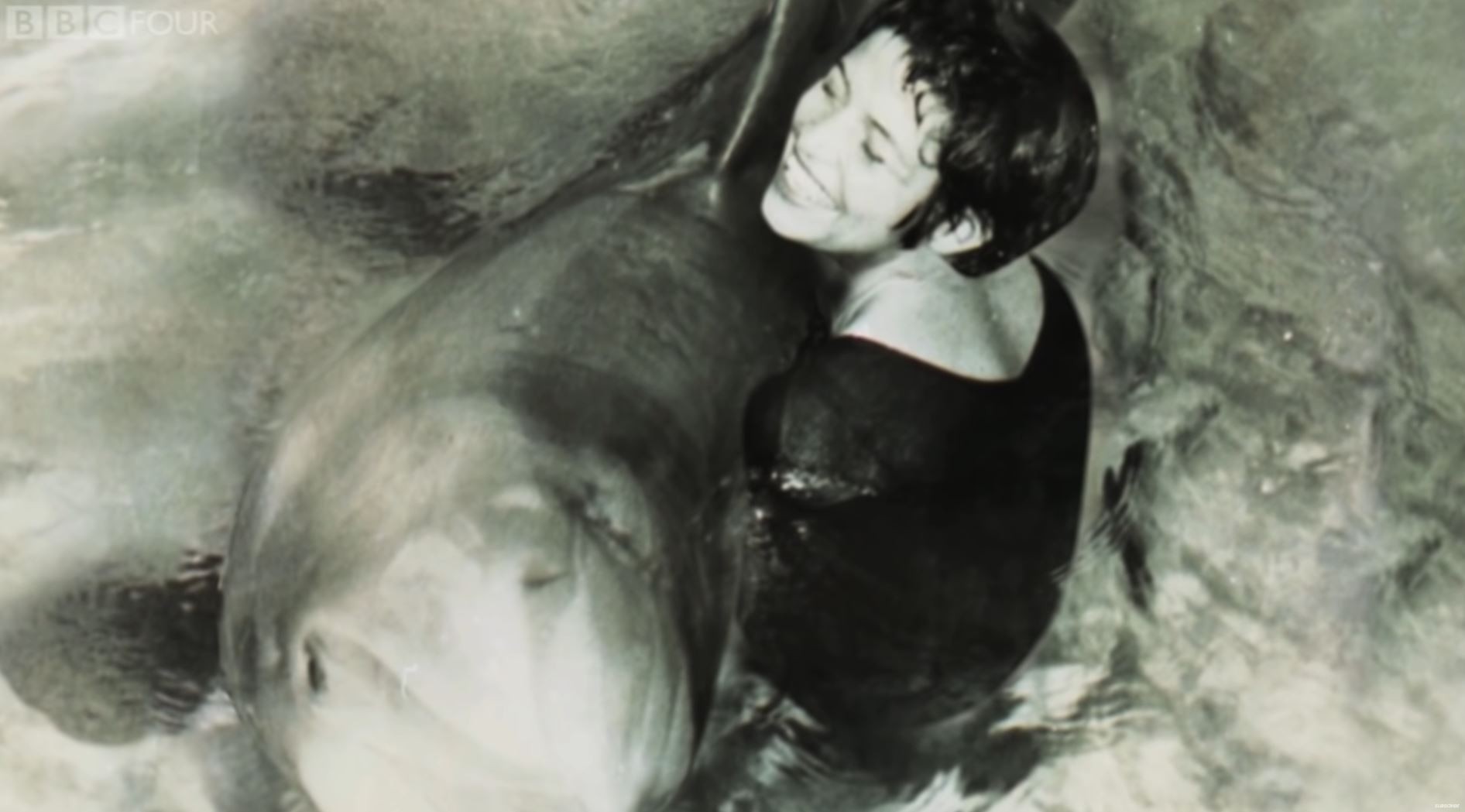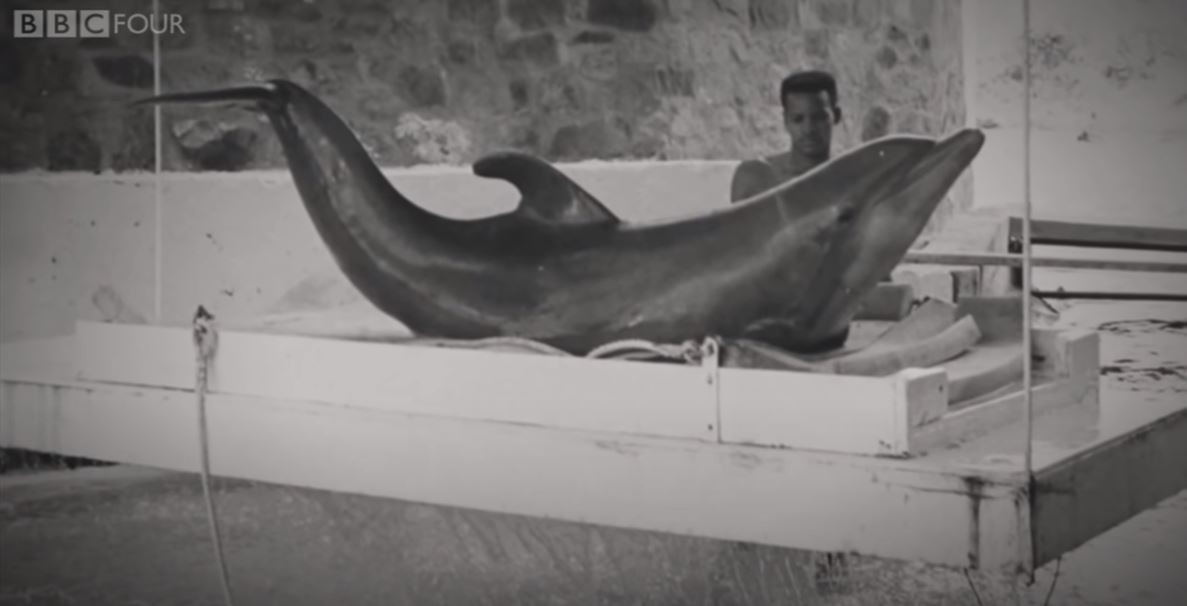What Happened To Peter The Dolphin? A heartbreaking story surrounds Peter, a dolphin involved in a 1960s NASA-funded experiment, and his profound connection with researcher Margaret Howe, which allegedly ended in tragedy. Join PETS.EDU.VN as we explore this captivating tale, examining the emotional depths of dolphins and the ethical considerations of animal research. Discover fascinating insights into dolphin behavior, intelligence, and the delicate balance between scientific exploration and animal welfare.
1. The Extraordinary Bond Between Peter and Margaret
In the 1960s, amidst the backdrop of ambitious scientific endeavors, a unique experiment unfolded at the Dolphin Point Laboratory in St. Thomas, Caribbean. Led by Dr. John C. Lilly, the project aimed to explore interspecies communication by teaching dolphins to understand and mimic human speech. Central to this research was Peter, a six-year-old bottlenose dolphin, and Margaret Howe, a 23-year-old research assistant. Their story became a testament to the deep emotional connections that can form between humans and animals.
Margaret and Peter lived together in a specially designed “Dolphin House,” a partially submerged structure where they shared their daily lives. Margaret spent her days in the water with Peter, attempting to teach him English through constant interaction and play. This unusual living arrangement fostered an environment where a remarkable bond flourished.
The experiment was more than just a scientific study; it was a shared experience that blurred the lines between researcher and companion. Margaret’s dedication and Peter’s intelligence created a dynamic where learning and affection intertwined, revealing the complexities of animal emotions. Visit PETS.EDU.VN to uncover more stories about extraordinary animal-human relationships and the science behind them.
2. The NASA-Funded Experiment: A Quest for Interspecies Communication
The NASA-funded experiment involving Peter the dolphin was driven by a forward-thinking yet unconventional goal: to establish communication with extraterrestrial life. Dr. John C. Lilly, a neuroscientist known for his pioneering work on dolphin intelligence, believed that understanding dolphin communication could provide a blueprint for communicating with alien species.
The Dolphin House was constructed to facilitate constant interaction between Margaret and Peter. The facility allowed Margaret to live in close proximity to Peter, creating an immersive environment for language acquisition. The goal was ambitious: to teach Peter to mimic human speech through his blowhole, a feat that Dr. Lilly predicted could be achieved within a decade or two.
However, the experiment’s focus shifted as the relationship between Peter and Margaret deepened. While the primary objective remained the same, the emotional dynamics between the two became a central aspect of the study, raising profound questions about animal emotions and the ethics of animal research. Delve deeper into the ethics of animal research and the latest findings on animal intelligence at PETS.EDU.VN.
3. The Blossoming of an Unconventional Romance
As the weeks passed, the relationship between Peter and Margaret evolved beyond that of a subject and researcher. Peter began to exhibit signs of affection towards Margaret, displaying behaviors that his vet described as “falling madly in love.” He would playfully nibble at her, rub against her legs, and seek her constant attention.
Margaret, too, acknowledged the deepening emotional bond. She described missing Peter when he wasn’t around and enjoying their time together. However, she also noted the complexities of their relationship, particularly the sexual aspect. As Peter’s urges became more pronounced, Margaret made the controversial decision to pleasure him to maintain his focus on the experiment.
She clarified that while the experience was sensual, it wasn’t sexual for her, but she recognized its importance for Peter. This intimate interaction further blurred the lines of their relationship, raising ethical questions and sparking debate about the nature of animal-human connections.
To delve deeper into the complexities of animal emotions and the ethical considerations of animal-human relationships, visit PETS.EDU.VN for expert insights and resources.
4. The Experiment’s End: Separation and Heartbreak
Despite the progress made in understanding dolphin communication and the unique bond formed between Peter and Margaret, the experiment was abruptly terminated when funding ran out. The Dolphin House was closed, and Peter was relocated to Dr. Lilly’s smaller lab in Florida, over 1,000 miles away from Margaret.
The separation had a devastating impact on Peter. Accustomed to constant interaction and affection from Margaret, he struggled to adapt to his new environment. Confined to cramped conditions without his human companion, Peter’s health deteriorated rapidly.
Within weeks, the seemingly heartbroken dolphin died. Dr. Lilly informed Margaret that Peter had committed suicide, a claim supported by the lab’s vet, Andy Williamson, who attributed Peter’s death to a broken heart. Ric O’Barry, founder of The Dolphin Project, echoed this sentiment, explaining that dolphins are conscious breathers and can choose to sink to the bottom of the water and not take another breath if life becomes too unbearable.
The circumstances surrounding Peter’s death sparked intense debate among scientists and animal welfare advocates. While some argue that dolphins lack the cognitive capacity for suicide, others point to evidence of self-destructive behavior in distressed animals as indicative of emotional suffering. Learn more about dolphin behavior and the impact of captivity on these intelligent creatures at PETS.EDU.VN.
5. The Controversy Surrounding Peter’s Death: Suicide or Self-Destructive Behavior?
The question of whether Peter the dolphin committed suicide remains a contentious issue. Scientists are divided on whether dolphins possess the mental capacity to engage in suicide in the same way humans do. However, there is ample evidence that distressed animals can exhibit self-destructive behaviors that may prove fatal.
Lori Marino, a behavioral neuroscientist and dolphin expert, argues that dolphins have sophisticated emotional capacities and complex thinking processes that could lead to suicidal thoughts. She points to their large brains, complex social structures, and self-awareness as evidence of their emotional depth.
Other scientists suggest that Peter’s death was more likely the result of depression and a loss of will to live. The abrupt separation from Margaret, combined with the confined conditions of his new environment, may have triggered a state of despair that led him to stop breathing.
Regardless of the precise cause, Peter’s death highlights the profound impact that emotional distress can have on animal health and well-being. Discover more about the emotional lives of animals and the factors that contribute to their well-being at PETS.EDU.VN.
6. Ethical Implications of the Dolphin Experiment
The Peter the dolphin experiment raises significant ethical questions about the use of animals in scientific research. While the goal of understanding interspecies communication was ambitious and potentially beneficial, the methods employed in the experiment have come under scrutiny.
The close living arrangement between Margaret and Peter, particularly the intimate nature of their interactions, raises concerns about the potential for exploitation and harm. Critics argue that the experiment prioritized scientific goals over the welfare of the animals involved, leading to Peter’s emotional distress and eventual death.
The case of Peter the dolphin serves as a reminder of the importance of ethical considerations in animal research. It underscores the need for researchers to prioritize animal welfare, minimize harm, and ensure that scientific goals are balanced with the rights and needs of the animals involved. For a deeper understanding of ethical guidelines in animal research and welfare, visit PETS.EDU.VN.
7. Remembering Peter: A Legacy of Awareness and Change
The story of Peter the dolphin has left a lasting legacy, raising awareness about dolphin intelligence, emotions, and the ethical treatment of animals. His story has inspired countless individuals to advocate for improved animal welfare standards and to question the use of animals in scientific research.
Peter’s story has also contributed to a growing understanding of the complex emotional lives of dolphins. Scientists have increasingly recognized their capacity for empathy, self-awareness, and complex social interactions. This understanding has led to greater efforts to protect dolphins in the wild and to improve their living conditions in captivity.
Today, Peter the dolphin is remembered as a symbol of the need for compassion and respect for all living creatures. His story serves as a reminder that animals are not simply research subjects but sentient beings with emotions, needs, and the right to live a life free from unnecessary suffering. Join PETS.EDU.VN in honoring Peter’s legacy by supporting ethical animal treatment and promoting awareness of animal welfare issues.
8. Modern Perspectives on Dolphin Intelligence and Emotions
Modern research continues to reveal the remarkable intelligence and emotional depth of dolphins. Studies have shown that dolphins possess:
- Self-awareness: Dolphins can recognize themselves in mirrors, indicating a sense of self.
- Complex communication: Dolphins use a variety of vocalizations, including whistles and clicks, to communicate with each other. They even have signature whistles that act as individual names.
- Problem-solving skills: Dolphins can solve complex problems, such as navigating mazes and using tools to obtain food.
- Empathy: Dolphins have been observed displaying empathetic behavior towards other dolphins and even humans.
- Social complexity: Dolphins live in complex social groups with intricate hierarchies and cooperative behaviors.
These findings challenge the traditional view of animals as simple creatures driven by instinct. They suggest that dolphins are capable of complex thought, emotion, and social interaction, similar to humans.
| Feature | Description |
|---|---|
| Self-Awareness | Dolphins can recognize themselves in mirrors, a sign of self-awareness. |
| Communication | They use complex vocalizations, including signature whistles that function as individual names. |
| Problem-Solving | Dolphins can solve intricate problems and use tools to obtain food. |
| Empathy | They display empathetic behavior towards other dolphins and humans. |
| Social Complexity | Dolphins live in intricate social groups with established hierarchies and cooperative behaviors. |



To stay updated on the latest discoveries about dolphin intelligence and emotions, visit PETS.EDU.VN for in-depth articles and research summaries.
9. The Role of Sanctuaries in Dolphin Conservation
As awareness of dolphin intelligence and emotional needs grows, so does the movement to create sanctuaries for captive dolphins. Dolphin sanctuaries provide a more natural and stimulating environment for dolphins, allowing them to live in larger groups, engage in natural behaviors, and have more control over their lives.
These sanctuaries offer a refuge for dolphins who have spent years in captivity, often in small tanks and performing for audiences. By providing a more natural habitat, sanctuaries aim to improve the physical and psychological well-being of these animals.
Several dolphin sanctuaries have been established around the world, offering a glimpse into a more ethical and sustainable future for dolphin conservation. These sanctuaries demonstrate that it is possible to provide dolphins with a good quality of life without exploiting them for entertainment or research.
Explore the world of dolphin sanctuaries and learn how you can support their important work at PETS.EDU.VN.
10. What Can We Learn from Peter’s Story?
Peter the dolphin’s story offers valuable lessons about animal welfare, ethical research, and the importance of respecting the emotional lives of animals. It highlights the potential for harm when scientific goals are prioritized over the well-being of animals and underscores the need for compassion and ethical considerations in all interactions with animals.
Peter’s story reminds us that animals are not simply objects to be studied or exploited but sentient beings with their own unique needs and desires. By recognizing their intelligence, emotions, and social complexity, we can create a more just and compassionate world for all living creatures.
Here are some key takeaways from Peter’s story:
- Prioritize animal welfare: Ensure that the well-being of animals is always the top priority in research and conservation efforts.
- Promote ethical research: Support research methods that minimize harm and prioritize the rights and needs of animals.
- Respect animal emotions: Acknowledge that animals have complex emotional lives and deserve to be treated with compassion and respect.
- Support sanctuaries: Advocate for the establishment of dolphin sanctuaries to provide a more natural and humane environment for captive dolphins.
- Educate others: Share Peter’s story and other animal welfare issues to raise awareness and inspire change.
Join the PETS.EDU.VN community to continue learning, sharing, and advocating for animal welfare. Together, we can create a better future for all animals.
FAQ: Unveiling the Mysteries of Peter the Dolphin’s Life
1. What was the main goal of the Peter the dolphin experiment?
The primary goal was to study interspecies communication by teaching Peter to mimic human speech, hoping to find a blueprint for communicating with extraterrestrial life.
2. How did Margaret Howe and Peter the dolphin interact during the experiment?
Margaret and Peter lived together in a specially designed “Dolphin House,” where Margaret spent her days in the water, teaching him English and interacting closely with him.
3. What kind of emotional bond did Peter and Margaret develop?
They formed a deep emotional bond. Peter displayed affection towards Margaret, and Margaret acknowledged missing him when he wasn’t around.
4. Why did the Peter the dolphin experiment end?
The experiment ended when funding ran out, leading to the closure of the Dolphin House and Peter’s relocation.
5. How did Peter react to being separated from Margaret?
Peter struggled to adapt to the separation and confined conditions, leading to his rapid health deterioration.
6. What is the controversy surrounding Peter’s death?
The controversy revolves around whether Peter committed suicide or succumbed to self-destructive behavior due to depression and loss of will to live.
7. What are the ethical implications of the Peter the dolphin experiment?
The experiment raises ethical concerns about prioritizing scientific goals over animal welfare and the potential for exploitation in animal research.
8. How has Peter’s story impacted our understanding of dolphins?
Peter’s story has raised awareness about dolphin intelligence, emotions, and the need for ethical treatment, influencing efforts to protect dolphins and improve their living conditions.
9. What are dolphin sanctuaries, and why are they important?
Dolphin sanctuaries provide a more natural and stimulating environment for captive dolphins, promoting their physical and psychological well-being.
10. What can individuals do to honor Peter’s legacy?
Individuals can advocate for improved animal welfare standards, support ethical research, respect animal emotions, promote sanctuaries, and educate others about animal welfare issues.
Are you passionate about animal welfare and eager to learn more about how you can make a difference? PETS.EDU.VN is your go-to resource for expert advice, in-depth articles, and a supportive community of pet lovers. Whether you’re seeking guidance on ethical pet ownership, information on animal rights, or ways to support animal shelters and rescue organizations, PETS.EDU.VN has you covered.
Explore our website today and discover:
- Comprehensive guides on pet care, nutrition, and training
- Expert advice from veterinarians, animal behaviorists, and other pet professionals
- Inspiring stories of animal rescue and rehabilitation
- A vibrant community of pet lovers who share your passion
Ready to take the next step? Contact us today:
- Address: 789 Paw Lane, Petville, CA 91234, United States
- WhatsApp: +1 555-987-6543
- Website: PETS.EDU.VN
Let pets.edu.vn be your trusted partner in creating a better world for animals. Join us today and become a voice for those who cannot speak for themselves.